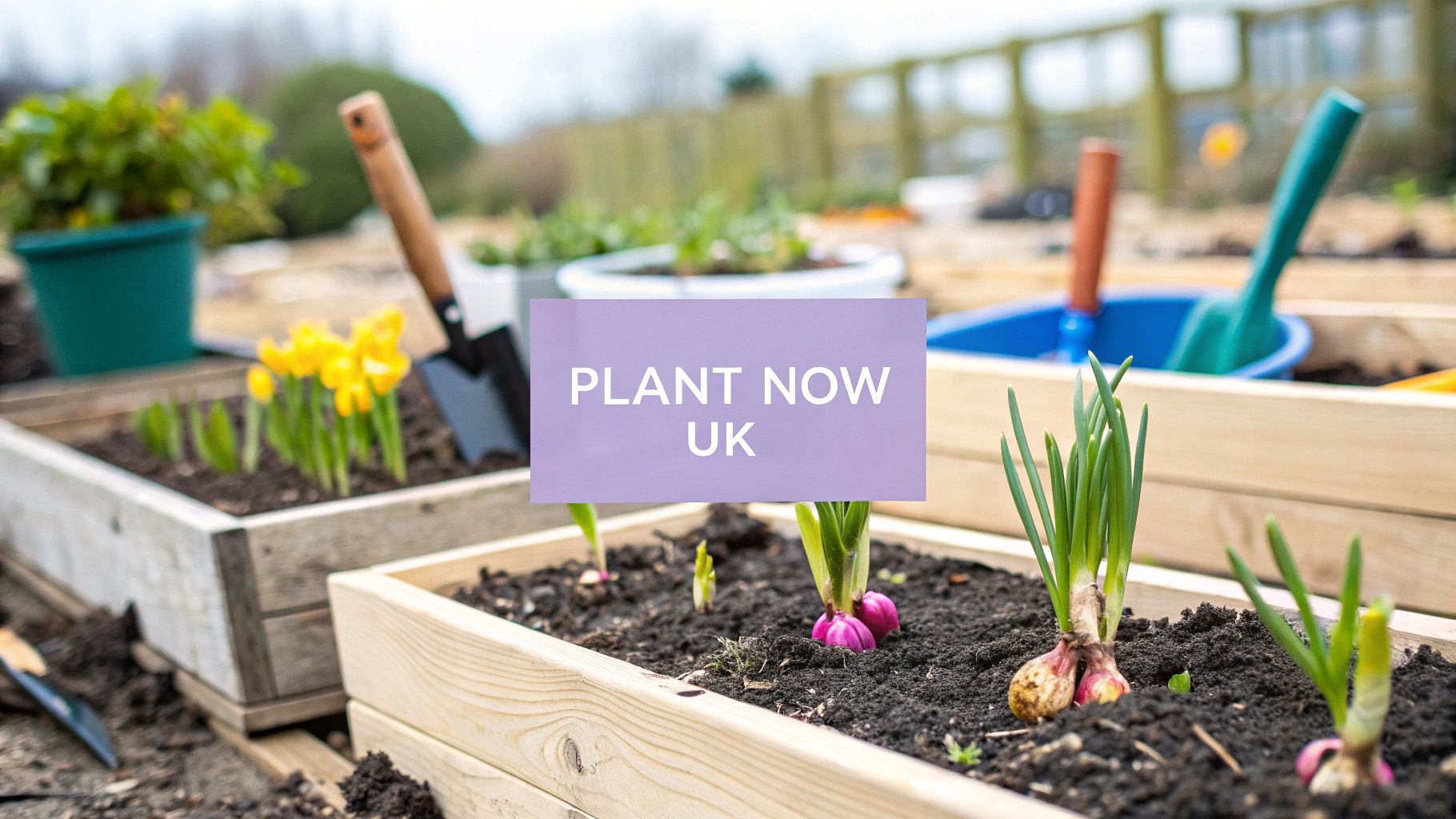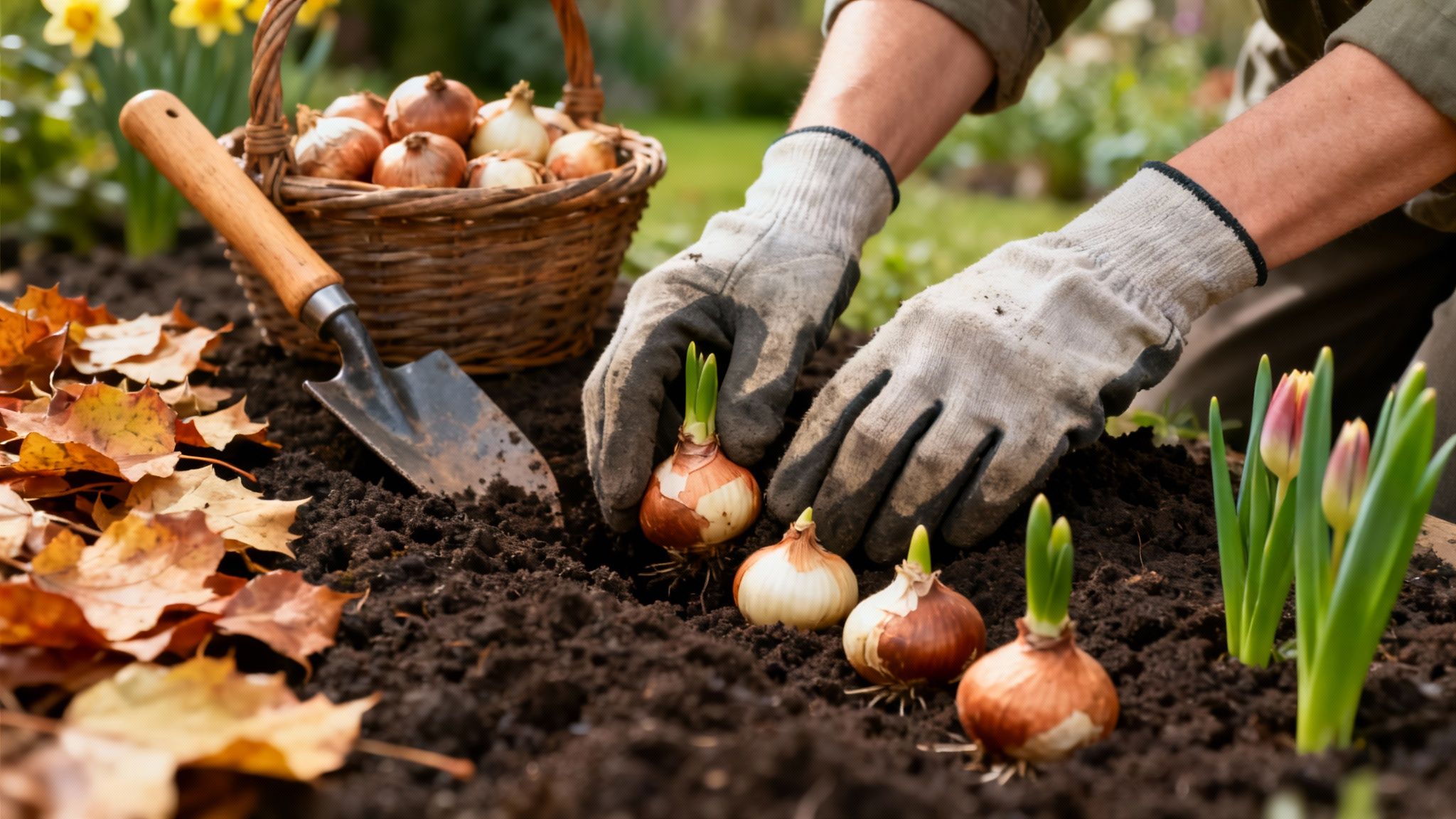As the seasons turn in the UK, the savvy gardener knows that now is the perfect time to lay the groundwork for a bountiful and beautiful year. Far from being a dormant period, autumn and winter offer a crucial window for planting a surprising variety of vegetables, flowers, and fruit. Planting now allows roots to establish in the cool, moist soil, giving them a powerful head start for vigorous spring growth.
This guide moves beyond generic advice to give you a clear, actionable list of what to plant now in the UK. We will explore everything from hardy vegetables like broad beans and garlic that promise an early harvest, to vibrant spring-flowering bulbs such as tulips and daffodils that will erupt in a riot of colour. You will also discover the best time to plant winter-hardy flowers, rhubarb crowns, and even bare-root fruit trees for future yields.
Forget guesswork. We’ll provide specific variety recommendations suited to the British climate and practical, expert tips to ensure your success, whether you have a large garden or a few pots on a patio. Let's dig in and discover the best plants to get in the ground right now for a spectacular year ahead.
1. Broad Beans (Fava Beans)
If you're wondering what to plant now in the UK for a delicious early summer crop, autumn-sowing broad beans are an outstanding choice. These exceptionally hardy legumes can be sown directly into the garden from October through to November, rewarding you with a harvest weeks ahead of spring-sown varieties. Their resilience makes them one of the most reliable winter vegetables for British gardens.
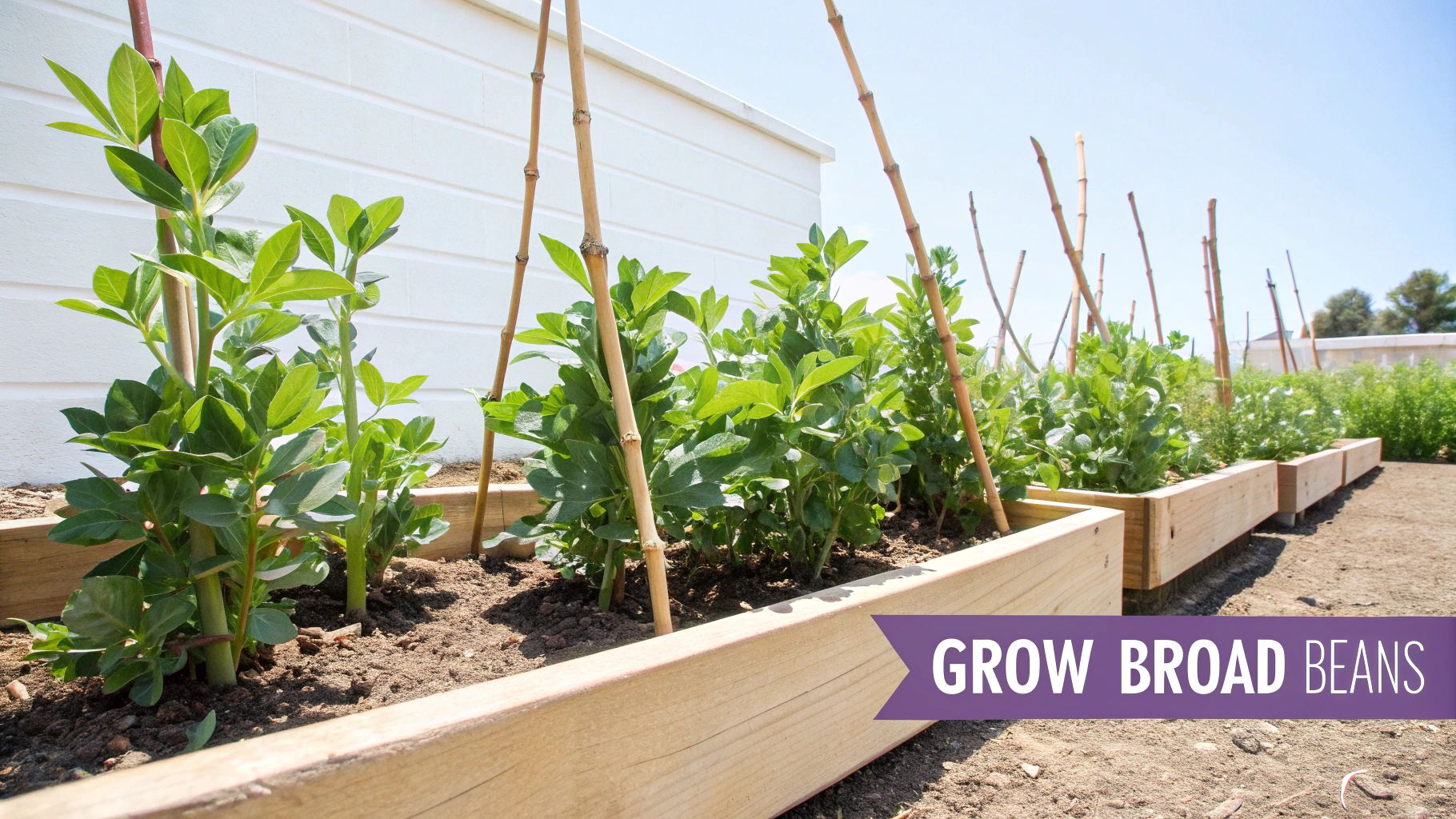
The primary benefit of an autumn sowing is the head start it gives the plants. While other parts of the garden lie dormant, these beans establish strong root systems. This early vigour means they are less susceptible to blackfly infestations which often plague spring-sown crops. Furthermore, broad beans are fantastic for soil health, as they fix atmospheric nitrogen, enriching the ground for whatever you decide to plant next.
How to Plant Broad Beans
Successful autumn sowing hinges on getting the basics right. Follow these steps for a robust crop:
- Choose the Right Variety: Opt for a winter-hardy variety specifically bred for autumn sowing. Aquadulce Claudia is a classic and reliable choice, known to perform well even in tougher climates like the Scottish Highlands.
- Site Selection: Find a sheltered, sunny spot with well-drained soil. This is crucial to prevent the seeds from rotting in cold, waterlogged ground over winter.
- Sowing Technique: Plant seeds 5cm (2 inches) deep. A double-row formation is highly effective: sow two parallel rows 23cm (9 inches) apart, with seeds spaced 23cm apart within each row. This allows the plants to support each other as they grow.
- Support: As the plants reach about 20cm in height, gently "earth up" the soil around their stems. This provides extra stability against winter winds. You can also install canes and twine for support before they get too tall.
Top Tips for a Bumper Harvest
Once your beans are established, a little care goes a long way. When the first tiny pods start to form at the base of the plant, pinch out the top 7-10cm of the main growing stem.
This simple action redirects the plant's energy into pod production rather than leafy growth and, most importantly, removes the soft, sappy tips that are a magnet for blackfly.
This technique is a tried-and-tested organic pest control method used by commercial growers and home gardeners alike, ensuring your plants stay healthy and productive.
2. Garlic
When considering what to plant now in the UK for a truly essential kitchen crop, garlic is a top contender. Planting in autumn is the key to success in most British climates, as the cloves require a prolonged period of cold weather, known as vernalisation, to split and form a full, juicy bulb. Sowing from October to December allows the cloves to establish strong roots before winter sets in, paving the way for a fantastic harvest the following summer.
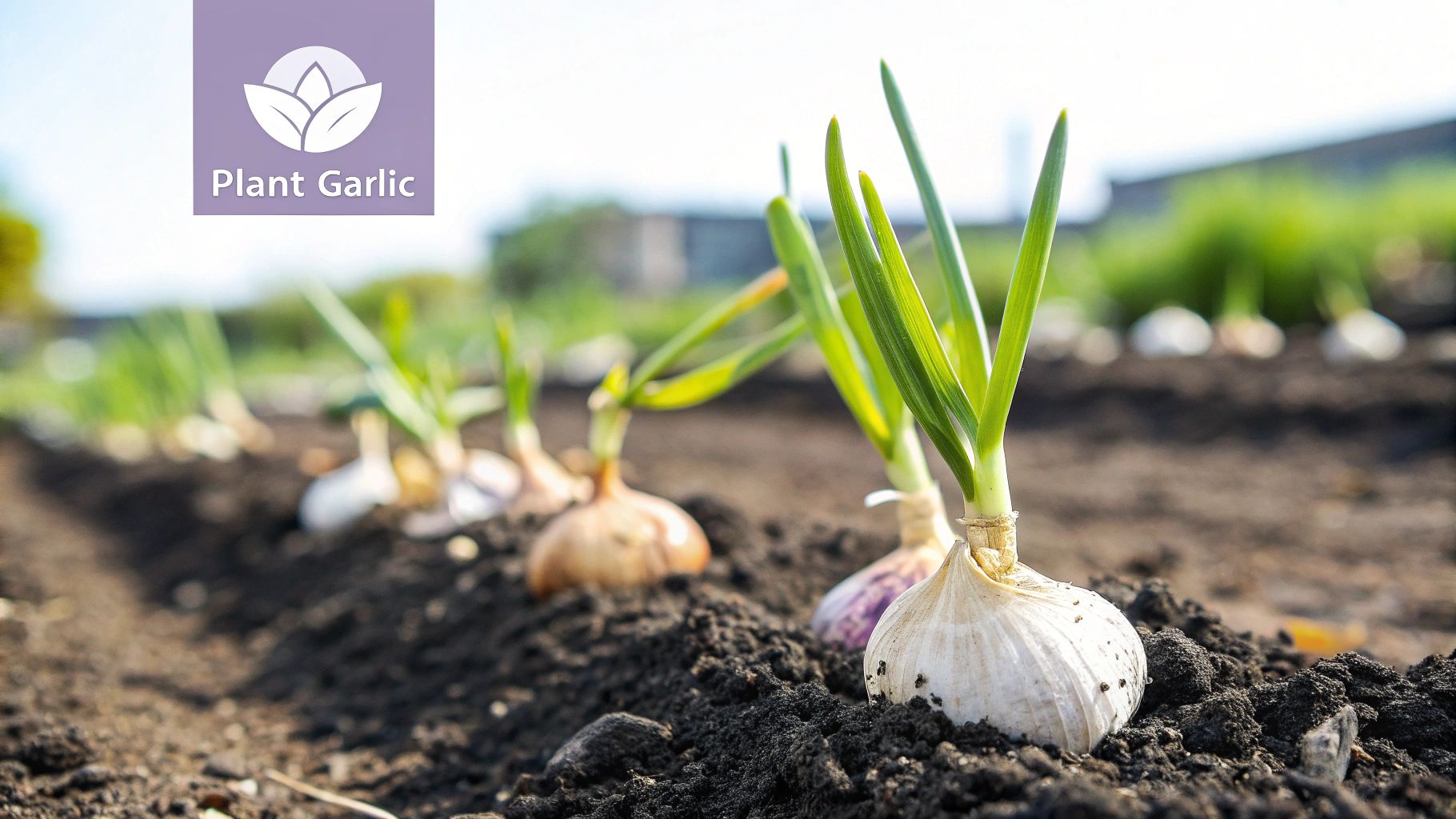
The primary advantage of autumn planting is that it satisfies the bulb's need for a cold snap, which is crucial for bulb division. This process results in a much larger, more flavourful yield compared to spring-sown garlic. Both hardneck varieties, which are extremely hardy and perfect for colder northern regions, and softneck varieties, which store for longer, can be planted now. This method is championed by experts like Hugh Fearnley-Whittingstall and used in demonstration gardens from RHS Wisley to community projects in Manchester.
How to Plant Garlic
Getting a great garlic crop starts with correct planting technique and good-quality cloves. Follow these steps for a successful harvest:
- Choose the Right Variety: Start with certified seed garlic, not bulbs from the supermarket which may carry diseases. Hardneck varieties like 'Purple Stripe' are excellent for cold areas, while softneck types such as 'Lautrec Pink' thrive in milder regions and store well.
- Site Selection: Garlic demands a sunny location with exceptionally well-drained soil. If your soil is heavy clay, consider planting in raised beds or pots to prevent the bulbs from rotting in wet winter conditions.
- Sowing Technique: Gently break apart the bulb into individual cloves. Plant each clove 5cm (2 inches) deep with the pointed tip facing upwards. Space them 10-15cm (4-6 inches) apart in rows to give each bulb ample room to swell.
- Pest Protection: Birds can sometimes pull up freshly planted cloves. To prevent this, you can cover the area with horticultural fleece or netting until the first green shoots are well-established.
Top Tips for a Bumper Harvest
Patience and proper timing are key to harvesting perfect garlic. Watch for the signs in early to mid-summer.
Harvest your garlic when the lower leaves have started to turn yellow and brown, but while there are still 6 or 7 green leaves remaining on the plant. Each green leaf represents a protective wrapper layer around the bulb, which is crucial for long-term storage.
Lifting the bulbs at this stage ensures they are fully formed but still encased in their protective skins. Leaving them in the ground for too long can cause the bulb to split open, reducing its storage potential.
3. Onion Sets
For gardeners seeking a head start on next year's harvest, planting onion sets in autumn is a brilliantly effective strategy. These small, dormant onion bulbs are one of the most reliable things you can plant now in the UK for a crop of large, well-flavoured onions early next summer. Planting in September or October allows them to establish strong roots over winter, leading to a more robust and earlier harvest than spring-planted sets.
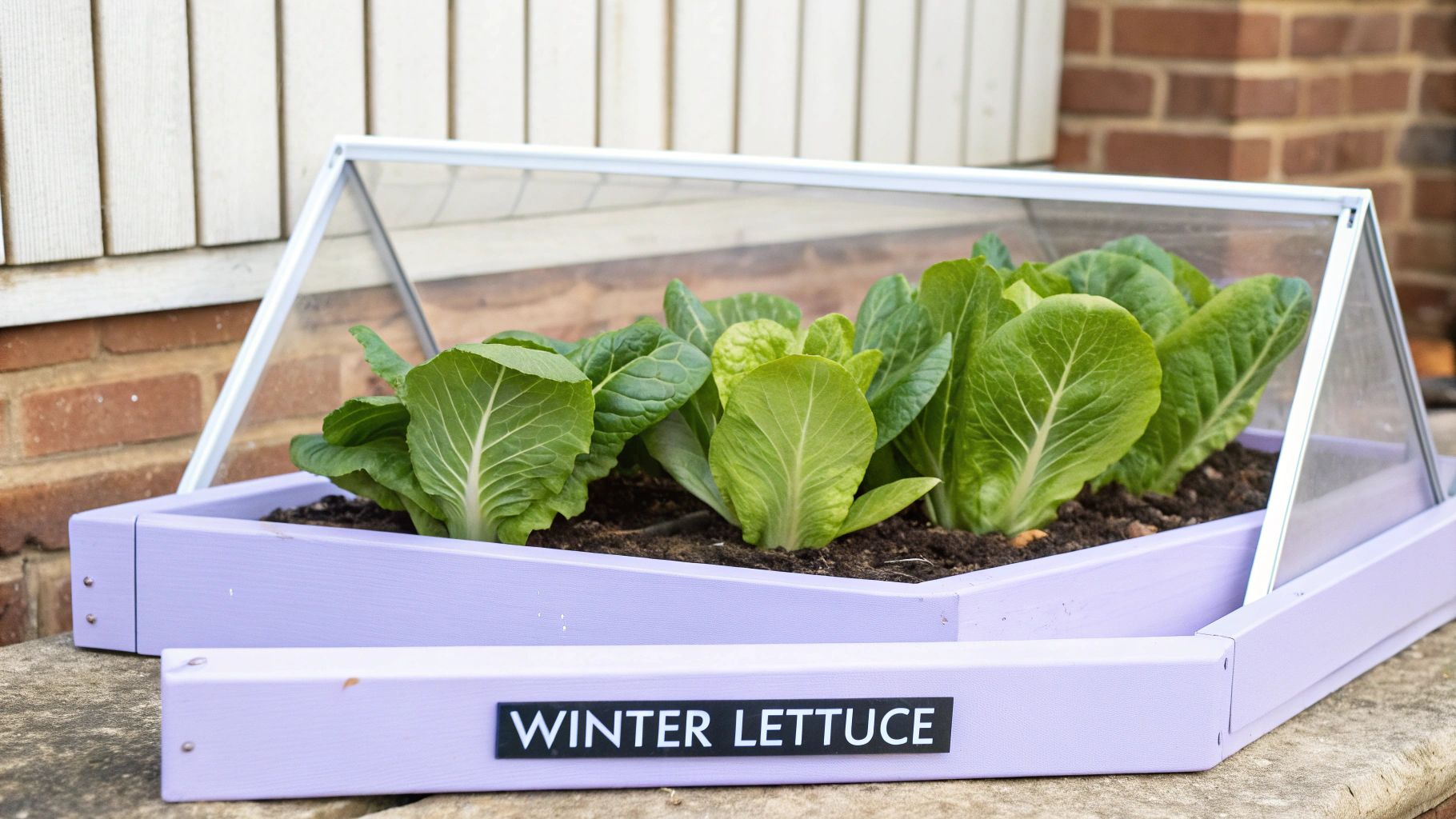
The key advantage of overwintering onions is their resilience and early maturity. By the time spring arrives, your onions will already be well-established and ready for a growth spurt, often avoiding the peak season for pests like onion fly. This method is particularly successful with Japanese varieties, which have been specifically bred by companies like Suttons Seeds to withstand the damp and cold of a typical British winter, as proven by decades of successful crops on allotments from Yorkshire to East Anglia.
How to Plant Onion Sets
Getting your onion sets into the ground correctly is vital for their winter survival and subsequent growth. Follow these steps for the best results:
- Choose the Right Variety: Look for sets specifically sold for autumn planting. 'Senshyu Yellow' is a popular and very reliable Japanese variety, while 'Electric' offers a vibrant red onion option.
- Site Selection: A sunny, sheltered position with fertile, free-draining soil is essential. Poor drainage can cause the sets to rot over the winter months.
- Sowing Technique: Gently push the sets into prepared soil so that only the very tip is visible. Space them 10cm (4 inches) apart in rows that are 30cm (12 inches) apart to give them ample room to swell.
- Protection: Birds, especially pigeons, are notorious for pulling up freshly planted sets. Cover the area with netting or horticultural fleece immediately after planting to protect them until they have rooted securely.
Top Tips for a Bumper Harvest
A common mistake is planting sets that are not in prime condition. A little careful selection can make all the difference to your final crop.
Always choose firm, dry sets and discard any that feel soft or show signs of sprouting or mould. This initial quality check prevents introducing disease into your soil and ensures each plant has the best possible start.
This simple act of quality control is a fundamental practice in both commercial growing and prize-winning vegetable cultivation, guaranteeing healthier plants and a more uniform, high-quality harvest next summer.
4. Winter Lettuce
If you’re craving fresh, homegrown salads during the bleakest months, then you need to know what to plant now in the UK for a winter harvest. Hardy winter lettuce varieties are specifically bred to withstand cold British weather, allowing you to enjoy crisp leaves right through until spring. Sowing in autumn provides a continuous supply when fresh garden produce is otherwise scarce.

The main advantage of growing winter lettuce is the extension of the salad season. These resilient plants grow slowly but steadily in the low light and cool temperatures of autumn and winter. With some basic protection, such as a cloche or cold frame, you can be harvesting your own fresh leaves for festive salads, a feat that feels particularly rewarding. Even a simple window box in a sheltered London spot can successfully grow a variety like 'Winter Gem'.
How to Plant Winter Lettuce
Success with winter lettuce relies on choosing the right varieties and providing minimal protection against the harshest weather. Follow these key steps:
- Choose the Right Variety: Select lettuces known for their cold tolerance. 'Arctic King' is an exceptionally hardy variety, while 'Winter Density' and 'All the Year Round' are also reliable choices for UK gardens.
- Site Selection: A sheltered, south-facing position is ideal to maximise winter sunlight. Growing in pots, window boxes, or under cloches provides essential protection from frost and cold winds.
- Sowing Technique: Sow seeds thinly in modules or small pots under cover from late August to October. Once seedlings are large enough to handle, transplant them to their final positions, spacing them about 20-30cm (8-12 inches) apart.
- Watering: Water sparingly, especially during cold, damp periods. Aim to water the soil, not the leaves, to help prevent fungal diseases like downy mildew.
Top Tips for a Continuous Supply
To ensure you have a steady stream of fresh leaves, the "cut-and-come-again" method is perfect for winter lettuce.
Instead of harvesting the whole head, simply pick the outer leaves from several plants as needed. This allows the central crown to continue producing new growth, giving you multiple harvests from the same plants over a long period.
This technique maximises your yield from a small space and ensures you always have the freshest possible leaves ready for your plate, providing a welcome taste of the garden throughout winter.
5. Tulip Bulbs
For an explosion of colour to banish the last of the winter gloom, planting tulip bulbs in autumn is a must. These iconic spring-flowering bulbs are a cornerstone of British gardens, from the grand Keukenhof-style displays at RHS Wisley to vibrant pots on a city balcony. Planting now, from October to late November, is crucial as tulips require a period of cold winter weather to trigger the biological process that leads to a successful bloom in spring.
The primary advantage of planting in late autumn, even into December in milder areas, is that the colder soil helps to suppress diseases like Tulip Fire, a fungal infection that can ruin a display. This timing gives the bulbs the necessary chilling period without leaving them sitting in warm, damp soil for too long. With hundreds of varieties available, you can choreograph a display that unfolds over several weeks, from early single varieties to flamboyant parrots and late-season doubles.
How to Plant Tulip Bulbs
Achieving a professional-looking display is all about the planting technique. Follow these steps for a stunning spring show:
- Choose the Right Variety: For perennial displays, opt for reliable species or Darwin Hybrid tulips, which are known for their vigour and ability to return year after year. Varieties like 'Apeldoorn' and 'Pink Impression' are excellent choices.
- Site Selection: Tulips demand a sunny spot with very well-drained soil. If you have heavy clay, it's essential to improve drainage or plant in pots.
- Sowing Technique: Plant bulbs to a depth of at least three times their own height. A good rule of thumb is around 15cm (6 inches) deep. Plant them with the pointed end facing up, spaced about 10-15cm (4-6 inches) apart for a full, impactful display.
- Soil Improvement: Before planting in borders, dig in plenty of horticultural grit or sharp sand. This prevents the bulbs from rotting during wet winters, which is the most common cause of failure.
Top Tips for a Bumper Harvest
For maximum impact, think in drifts rather than soldiers in a row. Planting in groups of at least seven or more creates a more natural and visually impressive effect.
Planting tulips deeper than often recommended not only helps anchor their tall stems but can also encourage certain varieties to perennialise more effectively, returning for several years of colour.
This deeper planting method is a simple trick used to improve the longevity and performance of your bulbs, giving you better value and beauty from your autumn efforts.
6. Daffodil Bulbs
When considering what to plant now in the UK for a spectacular and reliable spring display, daffodil bulbs are a classic and essential choice. Planting these hardy bulbs in autumn ensures they have the necessary chilling period over winter to produce a profusion of cheerful yellow, white, or bicoloured flowers from as early as February. They are exceptionally low-maintenance and resistant to deer and rodents, making them a truly rewarding investment for any garden.
The real magic of daffodils is their ability to naturalise, meaning they multiply and spread over the years to create breathtaking drifts of colour. This is seen in the iconic daffodil meadows of Welsh valleys and the historic collections at National Trust properties. Once planted, they will return year after year, each spring bringing a bigger and better display with almost no effort from the gardener. Their versatility allows them to be planted in borders, containers, or naturalised in lawns and woodland areas.
How to Plant Daffodil Bulbs
Successful planting in autumn is the key to a glorious spring show. Follow these simple steps for guaranteed results:
- Choose a Mix of Varieties: For a long-lasting display, plant a combination of early, mid-season, and late-flowering varieties. This can provide continuous colour from late winter right through to May.
- Site and Soil: Daffodils thrive in a sunny or lightly shaded spot with well-drained soil. They are not fussy but will rot in waterlogged ground, so improve heavy clay with grit and organic matter.
- Planting Depth: The general rule is to plant bulbs at a depth two to three times their own height. A deeper planting helps anchor the tall stems and protects the bulb.
- Nutrition Boost: Add a handful of bone meal or a specialist bulb fertiliser to the bottom of each planting hole. This provides the slow-release nutrients needed for strong root development and future flowers.
Top Tips for a Bumper Harvest
Ensuring your daffodils return year after year is simple if you follow one crucial piece of advice after they have flowered.
The most important step for next year's blooms is to allow the foliage to die back naturally for at least six weeks after flowering. Do not be tempted to cut it down or tie it in knots, as the leaves are gathering energy to store in the bulb for the following spring.
Once the leaves have turned yellow and withered, they can be removed. This patience will be rewarded with an even more impressive floral display the next year.
7. Winter Pansies
For anyone wondering what to plant now in the UK to bring vibrant colour to the darkest months, winter-flowering pansies are an absolute must. Specifically bred for hardiness, these cheerful annuals will bloom from autumn right through to spring, providing a continuous and welcome display when most of the garden is dormant. Their resilience makes them the foundation of countless winter container displays and garden borders across the country.
The primary advantage of planting winter pansies now is their ability to establish before the coldest weather sets in, ensuring they have the energy reserves to produce flowers even on milder winter days. They are incredibly versatile, perfect for brightening up window boxes, hanging baskets, and pots, or for filling gaps at the front of borders. Their defiant, colourful faces are a powerful antidote to the winter gloom.
How to Plant Winter Pansies
Getting the most from your pansies relies on good planting practice from the start. Follow these key steps for a season-long floral show:
- Choose the Right Variety: Look for plug plants or small pots labelled as 'Winter' or 'Universal' varieties. The Pansy 'Coolwave' series is a popular trailing type, ideal for baskets, while Pansy 'Matrix' offers robust, upright blooms in a vast array of colours.
- Site and Soil: Plant them in a spot that receives as much winter sun as possible. Whether in pots or borders, use a good quality, multi-purpose compost with added grit to ensure excellent drainage. This is vital to prevent roots from rotting in cold, wet soil.
- Planting Technique: Gently tease out the roots before planting. Space them about 15-23cm (6-9 inches) apart to give them room to grow and spread. This spacing also encourages good air circulation, which helps prevent disease.
- Watering: Water them in well after planting, aiming for the base of the plant to keep the leaves and flowers dry.
Top Tips for a Bumper Display
A little ongoing maintenance will keep your pansies performing at their peak. The single most important task is to regularly remove spent flowers.
Deadheading is crucial. By pinching off faded blooms at the stem, you prevent the plant from putting energy into seed production and instead encourage it to produce a constant succession of new flowers.
This simple act, performed every few days, can dramatically extend the flowering period and ensure your containers remain a focal point of colour throughout the winter and well into spring.
8. Rhubarb Crowns
For a long-term investment that yields delicious returns year after year, planting rhubarb crowns is an excellent task for the autumn. This quintessential British perennial is best planted as a dormant crown between October and November. Establishing it now allows the plant to settle in over winter, ready for vigorous growth in spring, eventually providing decades of reliable harvests when few other crops are available.
The primary advantage of planting rhubarb is its longevity and early harvest window. A well-sited crown can remain productive for 20 years or more, becoming a permanent, low-maintenance feature of your garden. Its tart stems are a welcome treat in early spring, perfect for crumbles and jams. Furthermore, its large, ornamental leaves can add a dramatic structural element to a vegetable patch or border.
How to Plant Rhubarb Crowns
Getting your rhubarb off to the best start is vital for its long-term health and productivity. Follow these key steps:
- Choose the Right Variety: Select a proven variety known for its flavour and vigour. Timperley Early is a popular choice for its reliability and early cropping, while Victoria is a classic heritage variety with an excellent balance of sweetness and acidity.
- Site Selection: Rhubarb thrives in an open, sunny spot with fertile, well-drained soil. It's a hungry plant, so enrich the planting area with plenty of well-rotted manure or garden compost beforehand.
- Sowing Technique: Dig a hole large enough to accommodate the crown's root system. Place the crown so that the very top of the growth bud is just visible at the soil surface. Planting too deeply can cause the crown to rot.
- Patience is Key: It is crucial to avoid harvesting any stems in the first year after planting. This allows the plant to dedicate all its energy to establishing a strong root system, which is essential for future yields.
Top Tips for a Bumper Harvest
Forcing rhubarb is a traditional technique used to produce an earlier crop of exceptionally sweet and tender stems. This method is famously employed in the "Yorkshire Rhubarb Triangle".
To force a crown, cover it with a large, lightproof container like an upturned bucket or a traditional rhubarb forcer in late winter. The lack of light encourages the plant to produce pale, tender stems that are less acidic than the main crop.
This simple trick provides a much-prized early harvest, rewarding your patience with a true garden delicacy. Don't force the same crown two years in a row; give it a year to recover.
9. Bare Root Fruit Trees
If your garden ambitions extend to growing your own fruit, autumn and winter are the perfect time for one of the most cost-effective and rewarding projects. Planting bare root fruit trees is an ideal answer for what to plant now in the UK. These are young, dormant trees sold without soil around their roots between November and March, offering a wider selection of varieties, including heritage types, at a fraction of the cost of potted trees.
The main advantage of planting during this dormant period is that the tree can establish its root system over the winter months, ready for a burst of vigorous growth in spring. This head start leads to a healthier, more robust tree that establishes more quickly than one planted in the warmer months. This method is used extensively, from community orchard projects inspired by groups like Common Ground to the restoration of heritage orchards by organisations like the National Trust.
How to Plant Bare Root Fruit Trees
Proper planting technique is vital for the long-term health and productivity of your tree. Follow these steps for success:
- Timing is Key: Plant as soon as possible after you receive your tree. If you can't plant immediately, "heel it in" by temporarily burying the roots in a trench of soil to keep them moist.
- Site Preparation: Dig a planting hole that is wider than the root spread but no deeper. The eventual soil level should match the nursery mark on the tree's stem, ensuring the graft union (the visible bulge near the base) is well above the soil line.
- Planting Technique: Create a small mound of soil in the centre of the hole and spread the roots out over it. Backfill the hole, gently firming the soil with your boot to eliminate air pockets.
- Support: Young trees need support against wind rock, which can damage new roots. Install a stake at an angle before backfilling the hole, and secure the tree to it using a proper tree tie, allowing for some movement.
Top Tips for a Bumper Harvest
Getting your tree into the ground is just the beginning. A little care in its first year will set it up for a lifetime of fruit production.
The most critical factor in the first growing season is consistent watering. Even in a damp British summer, a newly planted tree's root system isn't extensive enough to find its own water, so regular, deep watering is essential.
This ensures the tree doesn't suffer from drought stress, which can severely stunt its growth and delay its first harvest. Pruning for shape in the first few years is also crucial for developing a strong, productive framework.
Planting Guide: 9 Key Items for UK Now
From Planning to Planting: Your Next Steps to a Flourishing UK Garden
You've navigated the best options for your garden this season, from the foundational flavour of garlic and onions to the promise of spring held within a tulip bulb. This list has armed you with the essential knowledge of what to plant now in the UK, demonstrating that the "quiet" seasons are, in fact, teeming with potential for the proactive gardener. The key takeaway is that strategic planting now lays the groundwork for months, and in some cases years, of future reward.
By choosing even just two or three options from this guide, whether it's the hardy winter lettuce or a bare root apple tree, you are actively investing in the long-term health, beauty, and productivity of your outdoor space. You're not just filling soil; you're creating a future harvest, a future bouquet, and a future habitat for beneficial wildlife.
Turning Inspiration into Action
The bridge between knowing what to plant and having a flourishing garden is action. Your next steps are clear and achievable, so don't let the inspiration fade.
- Assess Your Space: Before you buy anything, take one last look at your garden, patio, or balcony. Where does the sun hit? Which areas are sheltered? Match the plant's needs (as detailed in our guide) to the specific microclimates in your own garden. For instance, a spot sheltered from harsh winds is perfect for winter pansies, while your sunniest patch is ideal for getting garlic established.
- Prepare Your Soil: This is a non-negotiable step for success. Take an hour this weekend to clear weeds and debris from your chosen planting areas. Incorporate well-rotted manure or garden compost to enrich the soil, giving your new plants the best possible start. This single act can dramatically improve the performance of everything from broad beans to rhubarb crowns.
- Source Quality Plants: Your results will only be as good as the seeds, bulbs, and crowns you start with. Seek out reputable UK nurseries or garden centres. Look for firm, healthy garlic cloves, plump onion sets without any signs of sprouting, and tulip bulbs that are heavy for their size. Quality inputs lead to quality outputs.
The Long-Term Vision for Your Garden
Mastering the art of seasonal planting transforms your relationship with your garden. It shifts from being a space of seasonal chores to a dynamic, year-round project that offers continuous rewards. Understanding what to plant now in the UK is a skill that builds momentum, with each successful crop or bloom fuelling your confidence for the next. This journey of continuous learning and experimentation is the very essence of great gardening.
Embrace the chill in the air as an invitation to get outside and connect with the soil. By taking these decisive steps today, you are cultivating more than just plants; you are nurturing a sanctuary of beauty, a source of fresh food, and a deep sense of accomplishment that will blossom in the seasons ahead. Happy planting

